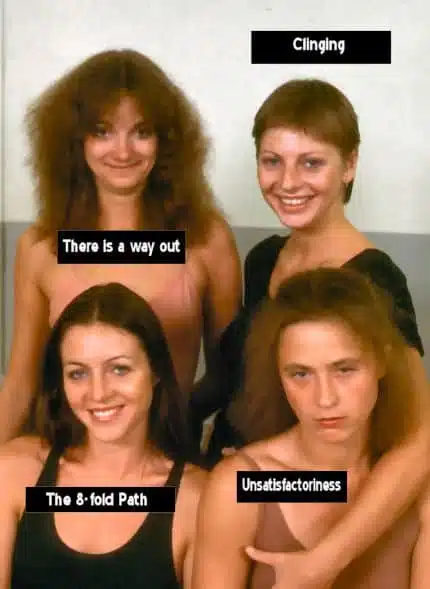4 Descriptors of the Way Life Is–the Buddha’s age-old wisdom (the Four Noble Truths) is perfect for helping us see through the clouds of the last few years.
Language Structure & Change, pg. 47)Let’s have a look at the Buddha’s Four Noble Truths, which I prefer to call the 4 Descriptors of the Way Life Is.

Looking for more on this topic?
Check out my book,
Half Asleep in the Buddha Hall.
My “Eastern” book takes you by the hand and helps you to find peace of mind.
Half Asleep in the Buddha Hall is a Zen-based guide to living life fully and deeply.

Many of the Buddhist texts were translated into English in the late 1800s. “Life is Suffering,” for example, is the first of the 4 Descriptors, and is a translation that is apropos of the 1800s. The actual Pali word that is translated as “suffering,” dukkha, is really about the unsatisfactory nature of life. Dukkha is commonly used to describe a range of feeling, from unease to suffering.
Suffering was a big deal to theologians and philosophers 100 years or more ago. For us, not so much.
It’s the same with “Noble” and “Truths.”
I certainly don’t use the word “noble” in my daily speech. A better translation is “important” or “preeminent.” And “truth” does not capture the essence of the Pali word sacca, which really means, “to be.” It refers to something that is “right there; is obvious.”
Thus, my shifting to 4 Descriptors of the Way Life Is. Once you see them, they are “right there,” and oh so obvious.
For now, let’s look at the 4th descriptor, what is called the 8‑fold Path.
Each of the 8 items on the path is typically prefaced with “Right,” as in Right View, Right Vocation, etc. Instead, I’ll follow Glenn Wallis, as conveyed in the book, Basic Teachings of the Buddha. He notes the same language translation issues I’ve mentioned above, and says that “Right” has the contemporary meaning of “correct,” as in right and wrong.
He proposes using the word “sound,” as in “that which leads to the result we seek.” I agree. “Sound” it is!
The 8 items on the 8‑fold path can be put into three groups:
- Understanding – Sound View, Sound Inclination
- Conduct – Sound Speech, Sound Action, Sound Livelihood, Sound Effort
- Attentiveness – Sound Awareness, Sound Concentration
A look at understanding
People operate out of a skewed view of how life is, and who they are. Our individual view is embedded into our sub-conscious minds through the normal “growing up and learning” process—something I call the ego development project.
This project is absolutely necessary—it is through this project that we self-identify, separate ourselves from “mother,” and develop a sense of “me / not me.”
It is the basic, first step in a lifetime of exploration – in a sense, it’s something that provides the convenience of our name/identity, but very little insight into “the way it is.”

Most people, however, stall right there, and spend the rest of their lives protecting and defending their ego identity, to the detriment of finding true contentment and an elegant way of being.
This is not their fault. It’s pretty hard to move past a socially acceptable place of being (especially as that artificial target keeps shifting,) to something entirely different. In a sense, without external intervention, or another point of reference, all we can expect is to be just like, or a little worse than, the social standard or norm.
Sound View
We could get into a long debate about what the alternative to the cultural norm is. I point to a perspective that is non-dual, self-responsible, and one in which I see myself as “that which is emerging from life (from is-ness) itself.” I have the choice to live in my head, lost in thought, finding myself dwelling in the past or the future. Or, I can come into moment-by-moment presence, recognizing that, by choosing to view life in this way, I have no permanent reality.
I am as I am, and then I become that which is, in the next moment.
From this place of expansiveness, I can choose. I can engage, or I can step back. I can let go, or I can embrace. I can shut down, or open up. Nothing is right or wrong (the non dual part) and nothing is required, other than presence.
I choose to see my life as a series of comings and goings, with no permanence to attach to. Things are as they are, and then they are something else. Which is sort of how we live our nomadic lifestyle…
This process of letting go (of non clinging) is the key to the practice.
Our egos desperately want us to be important, and tries to elevate everything we touch to “special, unique, and important.” Our egos are excessively invested in keeping the status quo, and remain a part of our ongoing experience until we die.
So, part of a sound view is tied up in how I see my ego.
I choose, then, to make peace with my ego, with my thoughts, with my emotions and feelings, and with my body. In other words, I do not ignore, sublimate, beat down, or disparage any of the “stuff” that accompanies being alive in a body. Nor do I elevate any of the stuff to the level of demigod. I am alive and having human experiences—and all of it is just as it should be.
The key to moving past an old view to a new one is gentle acceptance of what is, and who I am, while breathing into who I am becoming.
Sound Inclination
Inclination and view are paired. If our view is that “the world is unfair,” we will be inclined to be untrusting. If we view the world as “scary,” we will be inclined to be timid and reserved. If my view is that the movies I am running in my head are both “right and true,” my inclination will be to look for evidence that matches my invented film, and also to try to convince or manipulate others into accepting my view.
And on and on.
If our view shifts to “the way it is, is the way it is,” our inclination will be to treat the world with open-eyed wonder and curiosity. With this inclination, my eyes focus on what is before me. This includes thoughts which arise in me. I see “what is,” and I interact with it.
So, you might say that inclination is about intention, and interaction.
In other words, it’s not enough to say that you have a new view. It’s not enough to commit to following that view.
What is required is that final step of actually living in harmony and coordination with the view you espouse.
Most have difficulty here. I say to clients, “I don’t care what you say you will do, or what you say you understand. The only thing that matter is what you choose to do as you live your life.”

